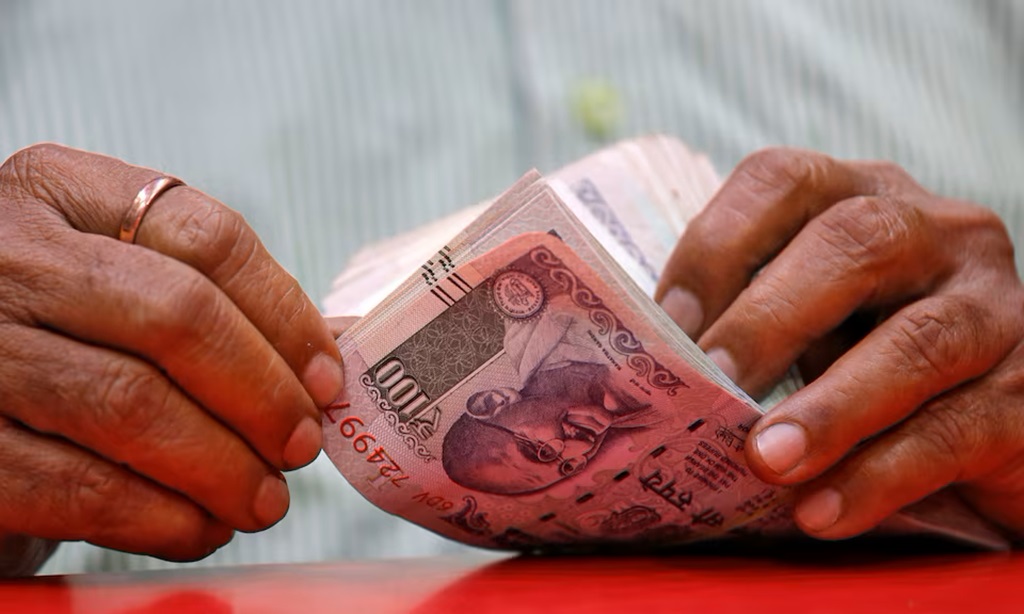The Indian rupee hit a new low versus the US dollar on Friday due to increased demand for dollars in the local market and a decline in the offshore Chinese yuan.
After falling 0.3% from Thursday’s closing of 83.1475 against the dollar, the rupee finished at 83.4250, its lowest closing level on record.
The Indian rupee plummeted 0.7% this week, its sharpest drop in seven months, and hit a session low of 83.43 near the session’s close.
The head of treasury at a medium-sized private bank noted that strong dollar buying in the last few minutes propelled the rupee past previous lows, despite the fact that the weakening yuan had been putting pressure on it since the session started.
According to Forex dealers, the rupee took a hit due to a lack of significant dollar inflows and an increase in the dollar index.
The Korean won lost 1.2% of its value and was the worst performer among Asian currencies. It was the lowest point since November when the offshore Chinese yuan fell.
According to Reuters, the yuan’s “weakness reflects increased jitters over geopolitical risks that have seemingly resurfaced”.
One trader from a foreign bank speculated that the rupee’s decline was due in part to a “artificial dollar scarcity” that showed up in the overnight dollar-Indian rupee swap rate, which was already low.
Traders noted that the Reserve Bank of India seemed to be absent towards the day’s close, despite the fact that the central bank had probably sold dollars earlier in the session near the 83.38-83.39 levels.
Considering Friday’s price action, Abhilash Koikkara, head of foreign exchange and rates at Nuvama Professional Clients Group, stated that the remaining days of March will most likely be “critical” for the Indian rupee.
According to Koikkara, the Indian Rupee’s bias is expected to turn negative if it stays near record lows over the next few days.
As a result of the Bank of Japan’s decision to boost interest rates for the first time in 17 years—a move that did nothing to support Asian currencies—the baht fell below 36 to the US dollar on Tuesday and is projected to go even more.
Thailand’s Baht hit a two-week low
According to Kasikorn Research Center (K-Research), the dollar could gain strength if the market believes the Federal Reserve will maintain US rates steady on Thursday.
The Thai Baht hit a two-week low of 36.04 in early morning trade and closed on Monday at 35.98 per dollar, according to Kanjana Chockpisansin, head of the research, banking and financial sector at the think tank. On Tuesday afternoon, the exchange rate was 36.07.
According to her interview with the Bangkok Post, K-Research has revised its baht trading prediction for later this week to 36.20-30 to the dollar.
For the first time since 2007, the Bank of Japan boosted its benchmark interest rate from -0.1% to a range of 0%-0.1%. This came after Japan’s largest corporations agreed last Friday to raise wages by 5.28% for 2024, and the yen plummeted to below 150 to the dollar on Tuesday as a result.
The increase eliminates the possibility of any nation having negative interest rates.
In addition to doing away with the acquisition of high-risk assets like exchange-traded funds, the central bank of Japan scrapped its extreme yield curve control strategy for Japanese government bonds.
But the watchdog promised to keep purchasing government bonds with maturities of several years.
“The Bank of Japan’s decision on rates is quite minimal and the market expected this kind of move, so it failed to improve the sentiment for other Asian countries,” Kanjana pointed out.
“No additional measures are likely to be launched by the bank at its next meeting late next month.”
According to K-Research, the dollar could gain even more ground versus Asian currencies if the Federal Reserve keeps the US interest rate constant on Thursday.
“The market expects the Fed will delay the first rate cut of the year from June to the second half, with less than three reductions this year,” according to her.
“The baht could trade at around 36.30 to the dollar by the end of the week, but if the Fed upgrades the US economic growth forecast, hinting rate cuts may be delayed further, then the dollar could strengthen and pressure a deeper baht slide.”







